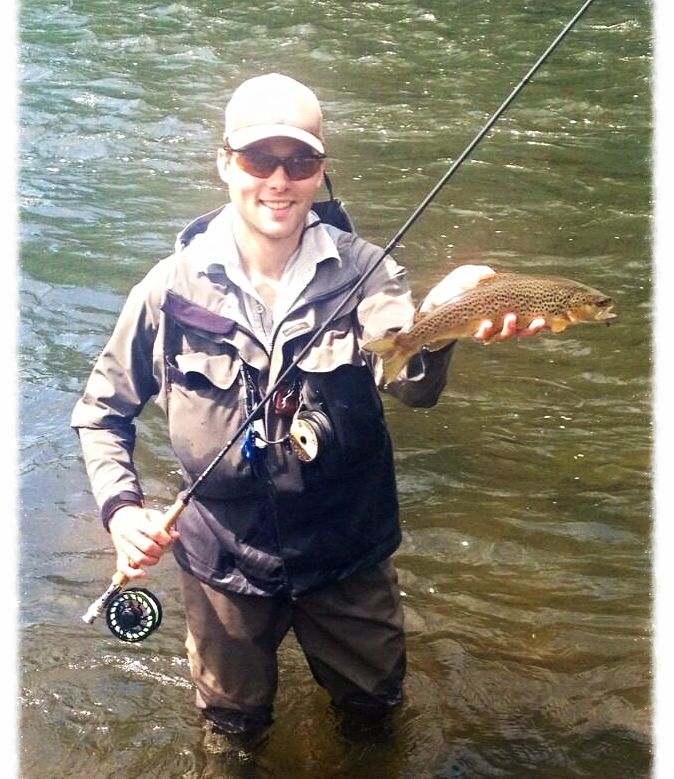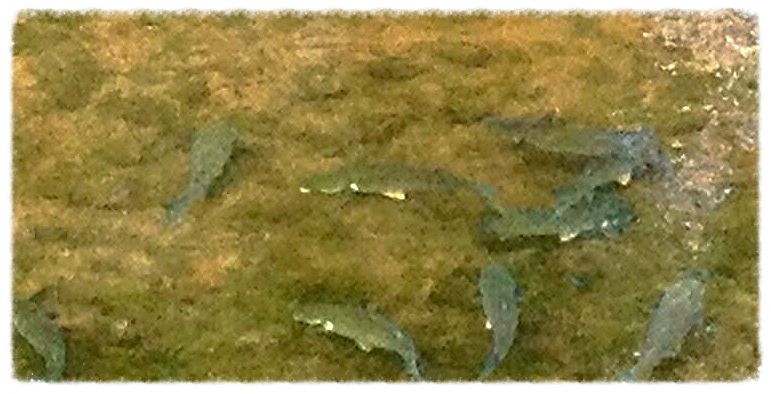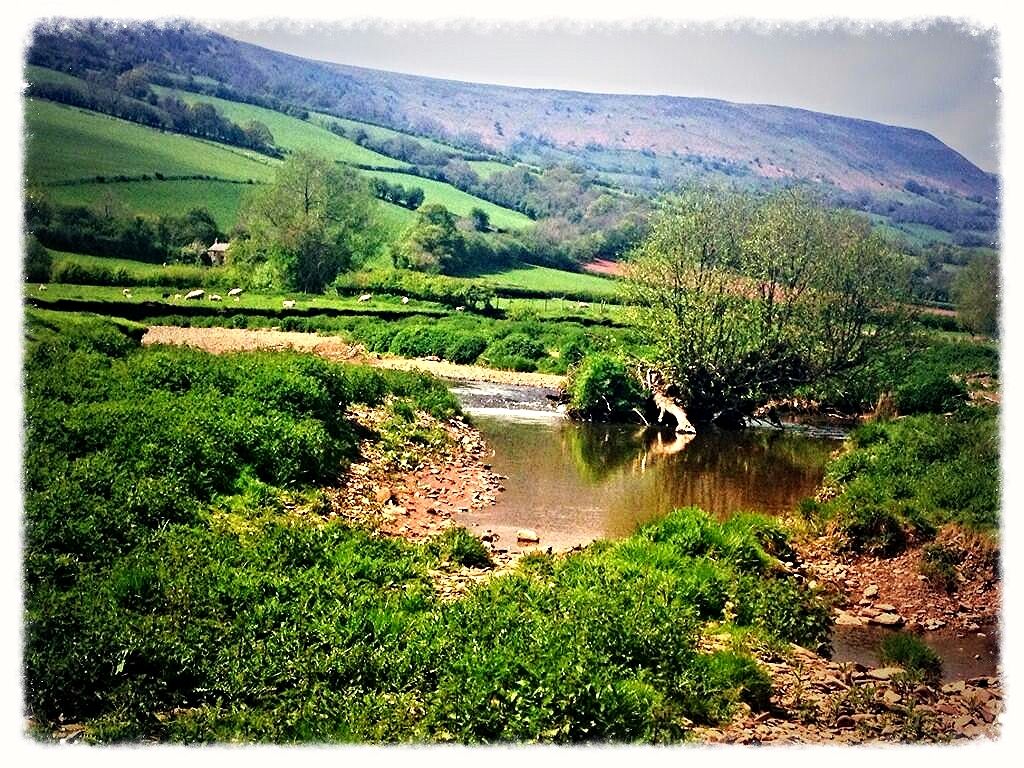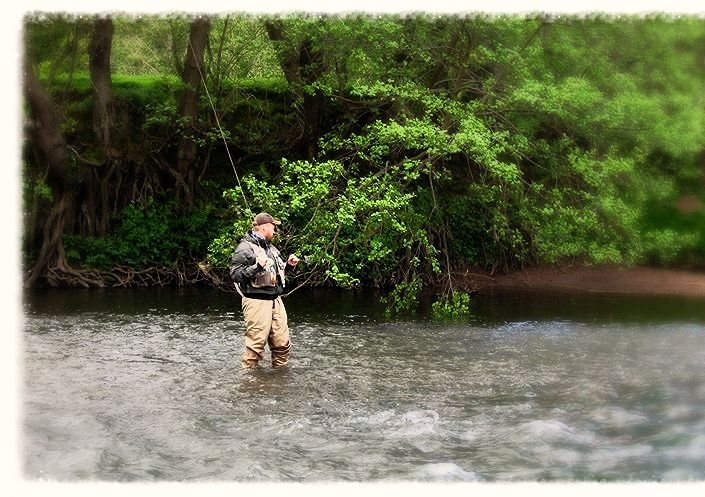No Rain
Despite maintaining good levels for the first half of the season, the Usk catchment has not received significant rainfall since late May and the bones of the river are on display.Hot dry spells dictate that I fish mainly in the relative cool of the late evening, or early morning. A busy work life, a dislike of most TV programmes and close proximity to the river results in many summer evenings spent fishing.
Home Visits
During the first half of June, I had the pleasure of fishing (on two separate days) with Kris and Nicholas. We caught quite a few, but didn't land the prized Usk two pounders that I had hoped for, and the nymph fishing was far less productive than earlier in the year. |
| Kris Kent - big man, small trout |
 |
| Nicholas - the spectra nymph does it again! |
Nicholas arrived the evening previous to our day and we stole a late hour (before returning to watch his nation lose in the World Cup). There were a few fish feeding and we caught on Yellow May Dun (YMD) emergers and Blue-Winged Olive (B-WO spinners). The B-WO spinner falls hadn't started properly but this provided a taste of things to come.
 |
| YMD emerger |
Early Evening
I started evening fishing during a warm period at the end of May. The fishing was erratic on those early summer evenings but the first few sessions provided some excellent sport. One memorable evening saw more than ten fish landed, with none under twelve inches. The largest was a lean old nineteen inch cock fish with a fierce kype and teeth that cut my finger. |
| Kyped cock fish |
 |
| Purple Haze - Usk trout |
 |
| Small nymphs for the Usk in summer |
Hook: Size 16 or 18 jig (Hannak or Fulling Mill)
Bead: 3mm, 2.5mm or 2mm Copper, black nickel or plain tungsten
Tail: Partridge
Body: Natural hare mixed (2/3) with olive hare (1/3)
Flash back: Pearl mylar or UV blob tail
Rib: Fine red wire
'Hackle': A turn of fine CDC
Collar: See body
I tied the nymph in the style of Craig McDonald's popular 'Duracell' and another nymph fished by Nicholas Steadman. A conversation with Nicholas (and noting his success), made me focus on the profile and resultant silhouette of the pattern and convinced me that partridge would provide the best material for the tail.
The first time I used it, I was fortunate enough to be lent a Hannak Czech Nymph rod to try out by Gareth at Harvey Angling. The high water temperatures drove me up river to a beat with numerous fast runs. That night, I caught many fish at the head of fast runs, with the biggest fish often holding right at the top.
 |
| Usk Leopard |
In low, clear conditions I either fish a French leader with two small nymphs or, more often, I 'high stick' a very long tapered leader with a duo set up.
 |
| Early evening nymph feeder |
 |
| Another to the summer nymph |
High Summer Spinners
In high summer the larger Usk trout usually start rising in the last hour before dark. An upwing spinner fall will see them feeding hard into the dusk, and some nights they can be heard crashing caddis until the small hours. |
| Caught on a skated bleached elk hair caddis |
 |
| Spent CDC & Elk and PP Para Spinners |
Drag and mircro drag are sport killers when fishing spent flies and, to minimise this, I move as close as I can to the quarry, often within two rod lengths. Good wading technique and patience are essential, particularly in low water; it often takes me five minutes to move into range.
When casting to fish, I usually employ a large upstream aerial mend and move the rod tip down stream at the same speed as the fly (or the speed I think my fly is moving in the dark!). I try to get into a rhythm that allows me to fish the fly effectively when it is too dark to pick it out.
 |
| Dark wader |
I use a 16 foot leader and, to take the flash off the line, rub it gently with a piece of grass held between my fingers. I can't recall where I read or heard this tip but it seems to work. To further reduce drag and ease lift off, I apply mucilin to the back two thirds of the leader.
Early in the season, when fishing big dry flies (such as Large Brook Dun patterns), I caught wily old trout using 5x diameter tippet. This does not work on the low, gin clear summer Usk. I have experimented with tippet diameters (particularly after reading Peter Hayes' book, 'Fishing Outside the Box'). My conclusions are the same as ever: I catch more fish with 7x than 6x and, when it is still relatively light, I struggle to catch any of the spooky summer trout with 6x.
 |
| Night release |
Those who believe that brown trout are rarely selective feeders should fish the Usk in June, July and August - the surface feeders are nearly always selective.
Reading the rise is important when targeting fussy feeders as you don't want to have to change your fly every few casts in the low light. A few evenings this year, I have gone out for the last hour anticipating spinner feeders only to observe fish feeding on B-WO and Danica duns (I have witnessed B-WOs hatching into the dark on sunny days). These dun feeders would not accept a spinner pattern, but readily accepted a dun.
 |
| Selective Usk trout |
Even in the high water temperatures, the Usk trout fight fiercely with most of the larger fish jumping and running towards snags in the shallow river. I thought the fish below was much larger then the 16 inches it turned out to be and, as it repeatedly ran to submerged tree roots, I feared being snapped. Pound for pound one of the best I've caught - the Manny Pacquiao of the trout world.
 |
| Pound for pound... |
Experience has taught me that my leader needs to be constructed correctly and I must play fish skilfully in order not to exhaust them in the warm water when using fine tippets. I prefer copolymer tippet and attach it to a shop bought 12 foot copolymer tapered leader using a two turn water knot (always being careful to ease knots down without pulling the end pieces too tight).
When fighting fish in open water, I try to play them on the reel as quickly as possible with the drag set appropriately to the tippet diameter. When I get it right, I'm occasionally rewarded with fish like the one pictured below.
 |
| A big fish to a PP B-WO Spinner |
Warm Feeling
 |
| The walk to the river |
 |
| Usk chub |
As the forecast tells us the dry spell is (hopefully) nearing an end, I feel that I've taken full advantage of the evening fishing this year; which is just as well. At the end of August, my wife is due to give birth to our first child leaving me to wonder (optimistically) if I'll be out as much next year.
 |
| In the gloaming |





































